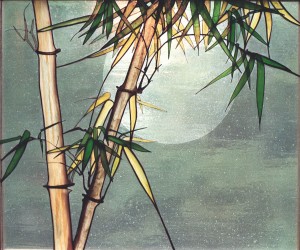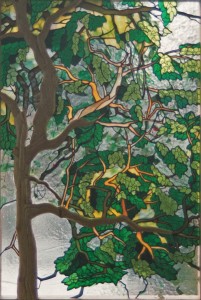Artist Profile
| Artist Profile: Robert N. Oddy |
| Jim Matthews |
This is the text of an article that appeared in THE SCORE , Issue No. 60, Sept 15, 1997, published by Spectrum Glass Co.
 Take a moment to appreciate the picture on page 2, bottom right [sic]: title and subject matter, “Bamboo.” This window (24″ x 30″) is composed of two primary layers. The foreground layer includes the two main bamboo stems and a number of leaves in a plane of clear seedy glass. The background layer is pale gray glass, a few more leaves, and a “hole,” where a lack of gray glass becomes the moon. Then, there are bamboo leaves mounted on both the front and back surfaces, those that appear to hang freely in space, looking completely natural, and mocking traditional stained glass design. This was the first stained glass window that Robert Oddy ever built.
Take a moment to appreciate the picture on page 2, bottom right [sic]: title and subject matter, “Bamboo.” This window (24″ x 30″) is composed of two primary layers. The foreground layer includes the two main bamboo stems and a number of leaves in a plane of clear seedy glass. The background layer is pale gray glass, a few more leaves, and a “hole,” where a lack of gray glass becomes the moon. Then, there are bamboo leaves mounted on both the front and back surfaces, those that appear to hang freely in space, looking completely natural, and mocking traditional stained glass design. This was the first stained glass window that Robert Oddy ever built.
“I don’t remember ever using a pattern,” says this English-born gentleman who taught himself the craft in 1983. Oddy had seen a stained glass kaleidoscope and, intrigued, soon found himself browsing a local glass retailer. “I bought a small booklet on the copper foil method, a glass cutter, a hand file, an iron, some foil and solder, and a five-dollar box of scrap glass. And I built a kaleidoscope.”
Oddy came to America in 1981 carrying a Bachelor’s degree in mathematics, a Masters in Computing, and a Ph.D. in Information Retrieval, all from fine British schools. His goal was to become a university mathematician. Looking back, he calls those goals “misguided” and praises the “unpredictability of life” that now finds him “enjoying life in Central New York and making stained glass windows.” In May of this year, Oddy resigned a Full Professorship at Syracuse University to devote himself to glass work full time.
One might expect that a strict and heavy focus on math and science would tend to suppress artistic abilities and inclinations. Certainly not in this case. Oddy recalls becoming aware of his abilities in advanced high school geometry classes. “We’d be given a mathmatic equation for a curve, and asked to sketch the curve without actually plotting the points. I noticed then that my sketching ability was pretty good; I could draw it quite clearly, while others, who knew what it should look like, couldn’t draw it.”
Today, when approaching a design for stained glass, Oddy first defines the “practical constraints” within which he must work — the needs and requirements of the client and the architectural setting. Then, disregarding the usual constraints of the medium (lead lines, impossible cuts, etc.), he just sketches the picture that he wants, deciding on form and balance of the whole, and working out the position and rough form of individual features. “My full scale cartoons are never complete. I carefully draw major lines and components of the design. Much of the detail is designed as I go along. For instance, I might build several separate blossoms or leaves (soldering the pieces together), without a template, and place them on the working cartoon. Then I will cut intervening pieces of glass, and sometimes reshape the assembled features to join with each other. So, parts of the window grow — sometimes outward from individual components, sometimes by filling spaces between features. I think, ‘…I am making a flower here … a real one … it is growing before my eyes …'”
Along with overall form and balance, Oddy seeks delicacy and depth in his creations. Look at “Bamboo” again. The “hole” that is the moon is not just a circle cut out of the background glass. That approach would have forsaken the inclusion of leaves or other detail on that layer. The moon gets its shape from multiple glass pieces — but they are unattached, not leaded or foiled together. Oddy carefully ground the pieces to diminish shiny edges, then butted them together to create invisible seams. Asked where he got the idea, he responds, “It just came to me one day … I was puzzling over how to get that effect, and it just occurred to me that I could get it by taking glass away.” Structurally, Oddy was careful to be sure the pieces were attached at enough points to make it sound, and then he protected it from behind with a sheet of clear glass to prevent dust or moisture from developing in the open seams. He’s used the technique in other projects since, with similar dramatic effect.
 Oddy admits that being self-taught has its disadvantages, saying, “You can reinvent the wheel unnecessarily.” However, one of the advantages that springs to life in his work is the clear lack of perceived limitations. No one ever taught Bob Oddy that certain things just couldn’t be done. He began “Spring Unicorn,” shown here, by hand-carving the trunk and branches of the enchanted tree from a single piece of hardwood. He then grooved the back side like a conventional wooden frame to receive the glass, and designed his glass cuts to fit the shape his carving had taken. This and a second window (“Autumn Dragon” – not shown) were created for the home of a children’s book author whose works feature mythical creatures.
Oddy admits that being self-taught has its disadvantages, saying, “You can reinvent the wheel unnecessarily.” However, one of the advantages that springs to life in his work is the clear lack of perceived limitations. No one ever taught Bob Oddy that certain things just couldn’t be done. He began “Spring Unicorn,” shown here, by hand-carving the trunk and branches of the enchanted tree from a single piece of hardwood. He then grooved the back side like a conventional wooden frame to receive the glass, and designed his glass cuts to fit the shape his carving had taken. This and a second window (“Autumn Dragon” – not shown) were created for the home of a children’s book author whose works feature mythical creatures.
Oddy’s background and education confound the notion that art and science are somehow mutually exclusive. Pondering that, he reveals remarkable insight: “The notion of art can be applied to more or less anything in life; just about anything you do can be done artistically. It’s the thing that goes beyond the technique, the component that gives you aesthetic pleasure in what you do.” Lesson well learned.
The works shown in this issue, and others, are reproduced in large, full color images in the Spectrum Art Glass Gallery at www.SpectrumGlass.com. Robert Oddy has his own website as well, where the full breadth of his incredible work can be appreciated. The URL is [www.RobertOddy.com]. He resides in Syracuse, New York.
web: www.robertoddy.com | mail: [email protected] | phone: (315) 200-2260
